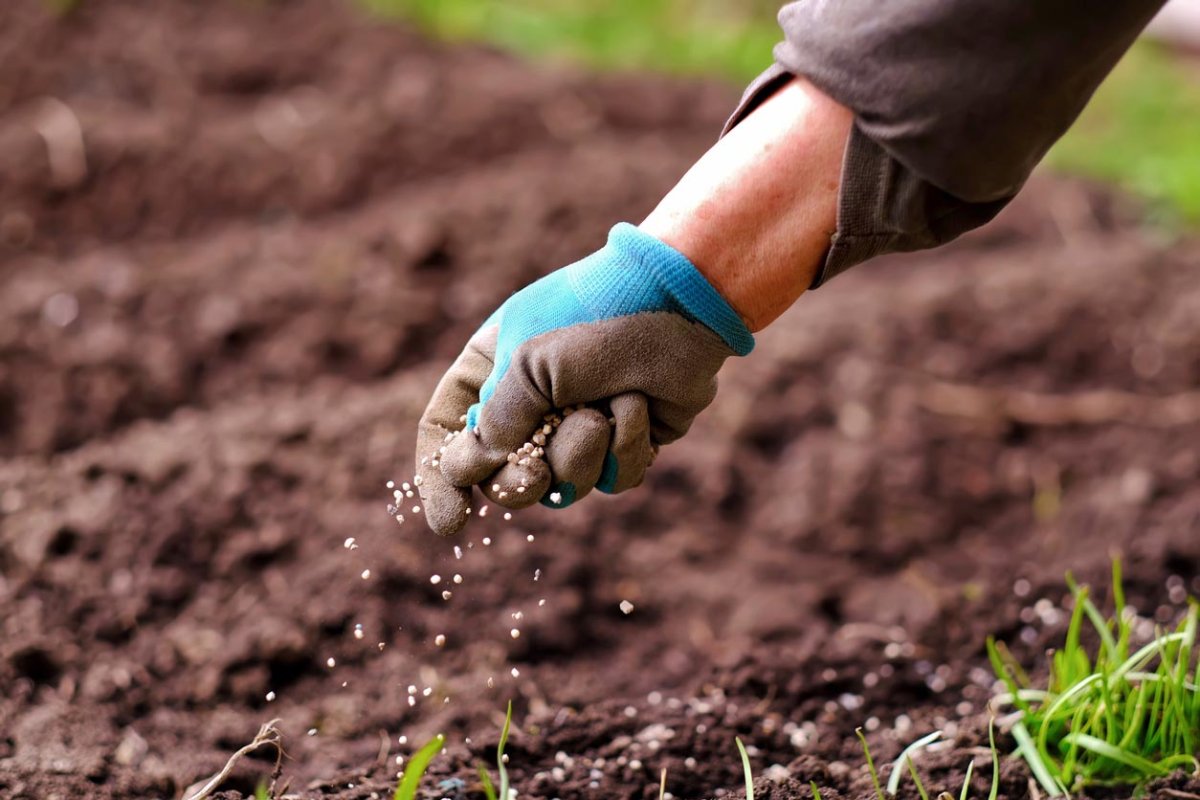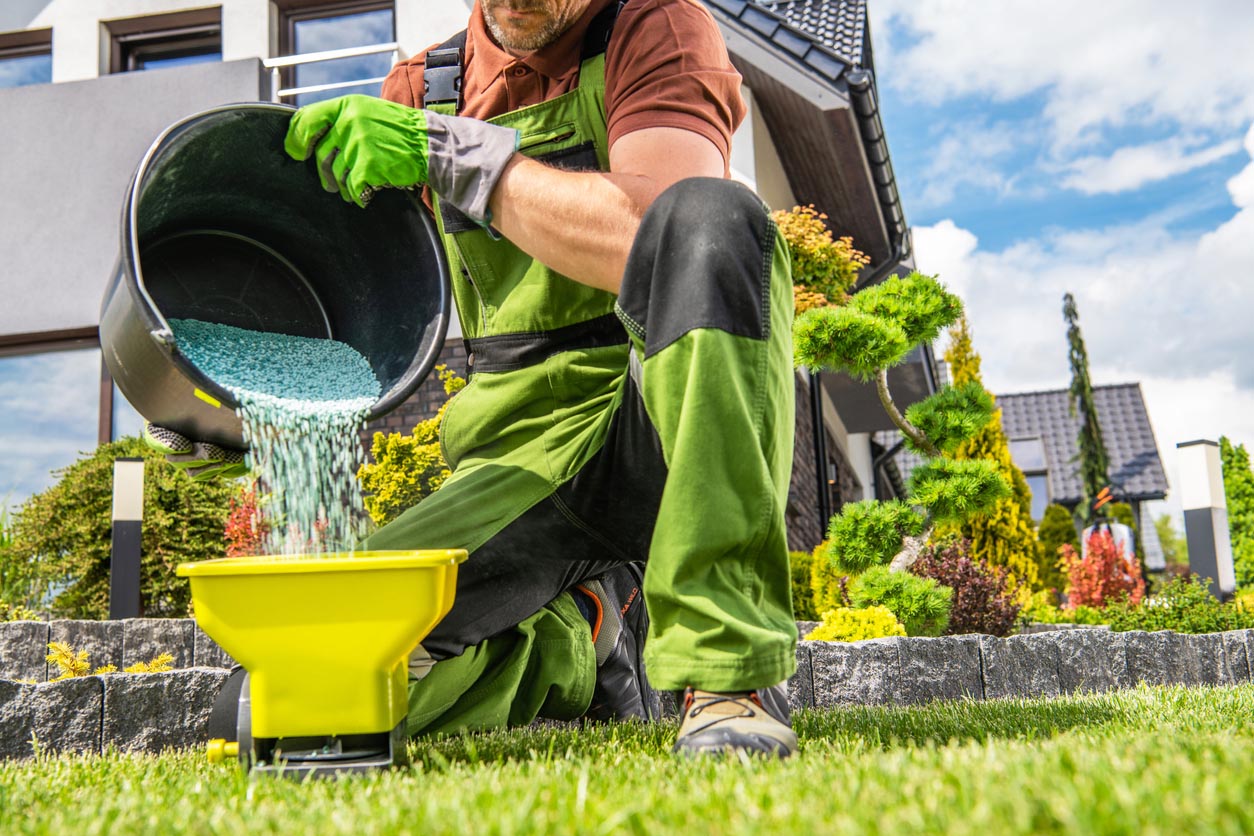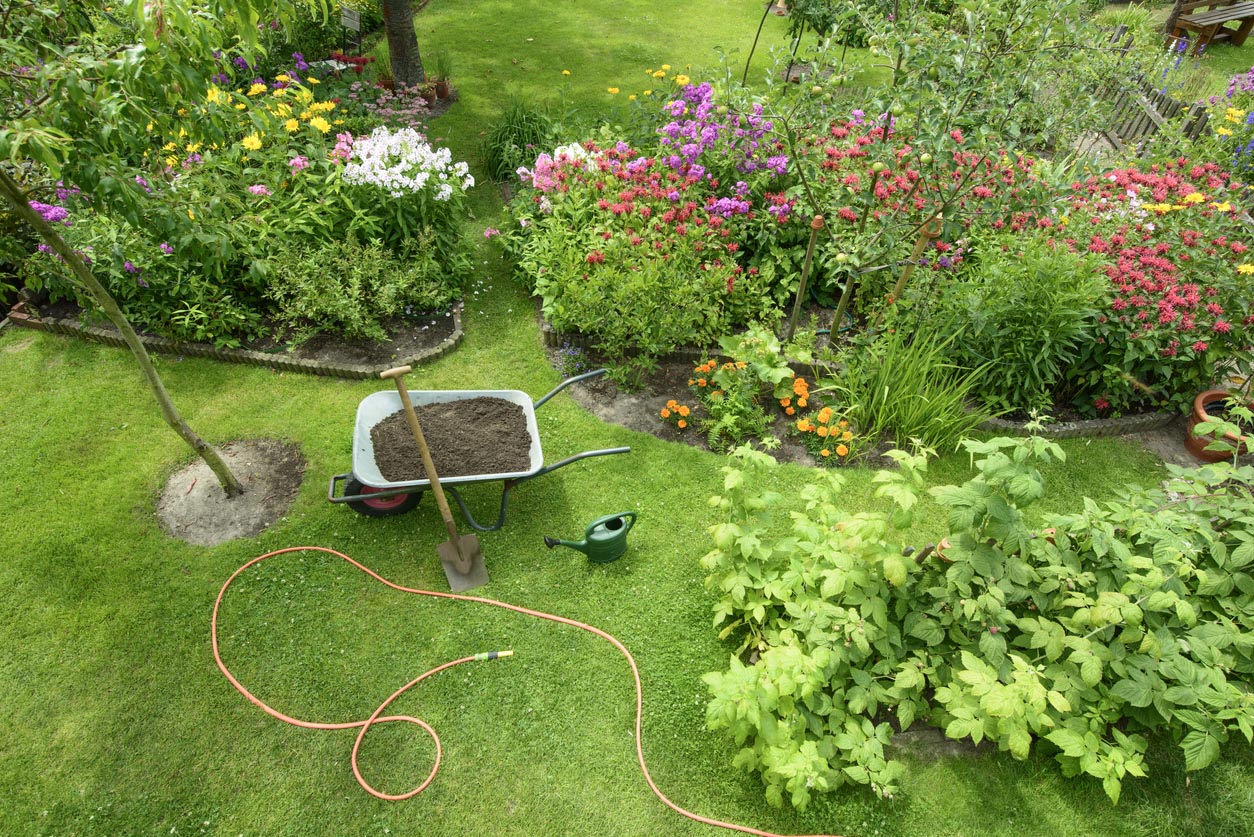

We may earn revenue from the products available on this page and participate in affiliate programs. Learn More ›
Q: I’m planning on planting new grass this year. What is the best fertilizer for new grass? Can I use the same fertilizer that’s used for an established lawn, or is there a fertilizer specific to new grass?
A: If you’re looking to grow healthier-looking green grass, applying fertilizer is an important step to take. However, the type of fertilizer you use will heavily depend on whether you’re starting a lawn from scratch (from seed or sod) or if you have an established lawn. To answer your question: Yes, there is a fertilizer that’s specific to new grass, and if you’re planning on growing your lawn from scratch this year, the fertilizer you’d use on an established lawn would be inadequate to meet the seedlings’ nutritional needs.
When starting grass from seed or freshly laid sod, it’s typically best to apply starter fertilizer before planting. Starter fertilizer contains vital nutrients that will help new grass establish its roots for strong growth throughout the season. But what is starter fertilizer for new grass, and how is it different from the fertilizer typically used for lawns? In this article we break down the key differences between these two types of fertilizer and explain why it’s important to choose the right one for your grass.

Fertilizing new grass is important to help a new lawn establish strong roots.

First, it’s important to fertilize new lawns whether they are started from seed or sod. While new grass seeds may germinate with just water and sunlight, this isn’t enough to establish a healthy lawn. Most soil lacks some nutrients, and fertilizer for new grass will give the grass the food it needs to grow fast and establish deep roots. The deeper the roots, the more drought-tolerant and hardy the grass will be overall. Failing to fertilize a new lawn can result in a weak lawn that’s more susceptible to brown spots, pest infestations, weeds, disease, and damage from mowing.
Choosing the right type of fertilizer is crucial; starter fertilizer is different from regular fertilizer, which doesn’t have the right ratio of nutrients for new growth.
When it comes to regular fertilizer versus starter fertilizer, the best kind to use depends on the stage of the lawn’s growth. The critical difference between regular and starter fertilizer is the amount of nitrogen, phosphorus, and potassium in the nutrient makeup. These nutrients have the following benefits for a lawn:
- Nitrogen stimulates growth of the grass blades and can result in greener-looking grass.
- Phosphorus stimulates root growth, which is important for a new lawn that is still establishing roots.
- Potassium assists grass in absorbing water and nutrients, helping it to survive diseases and pests in the long run.
The amount of each nutrient is indicated by the number on the fertilizer. For example, a fertilizer labeled 10-10-10 contains equal amounts of nitrogen, phosphorus, and potassium. Some states do not allow the sale of lawn fertilizers that contain phosphorus, since it can be harmful to fish if it runs off into a river or lake. For this reason, homeowners will want to consider whether they are able to purchase fertilizer containing phosphorus—or if they would prefer to avoid this ingredient, even if it’s available to them.

A starter fertilizer for new grass seeds will typically have a higher concentration of nitrogen to stimulate growth as well as phosphorus to help establish deep roots, both of which are important for a healthy lawn. Starter fertilizer is a quick-release fertilizer that is best used before seeding. If too much nitrogen is applied to an established lawn, it can burn and weaken the grass. On the other hand, applying a regular fertilizer to a new lawn likely won’t result in the type of growth the homeowner is looking for, since the nitrogen and phosphorus levels will be too low to create substantial new growth. The best starter fertilizers for overseeding can help the appearance of an existing lawn, so gardeners overseeding their lawns may want to look at fertilizers that have a higher concentration of nitrogen.
An ideal mix for new-lawn fertilizer would be 20-10-10, while an established lawn would likely get all the nutrients it needs to stay green and lush from a 30-0-0 or 27-3-3 mixture. Most fertilizers will list the levels of nitrogen, phosphorus, and potassium on the container so customers can choose the right kind of fertilizer for their lawn.
Some gardeners may even choose to create a homemade lawn fertilizer based on what is lacking in their current soil, but adding the right balance of each ingredient can be tricky. It’s best for the typical gardener to opt for a well-made product from a trusted company over making their own fertilizer—and ruining their lawns in the process.
Fertilizing new grass with starter fertilizer can be done right before or right after seeing; if laying down sod, the best time to apply your product will depend on whether it is slow- or quick-release.
When to apply a starter fertilizer depends on whether you choose to start from seed or sod, although the best course of action is to read the directions on the fertilizer container to determine the manufacturer’s recommended method of application.
When a homeowner is seeding a lawn, a starter fertilizer can usually be applied either before or after the seed. Working starter fertilizer into the soil prior to or after seeding will help make the nutrients readily available for the new seeds. If the fertilizer is applied after the seeds, it is important to water the grass after application to ensure the fertilizer is distributed into the soil evenly. After the starter fertilizer has been applied, it’s advised to wait about 6 to 8 weeks to allow the seeds to germinate before applying a regular, slow-release lawn fertilizer to help promote growth.
If a homeowner is laying down sod, the starter fertilizer application timeline will typically depend on whether the fertilizer is slow-release or quick-release. Slow-release starter fertilizer may be worked into the soil prior to laying the sod—this will give the newly laid sod access to all those nutrients that stimulate growth. However, if the sod has already been laid, it’s advisable to avoid using a starter fertilizer—or stick with a quick-release fertilizer—as a slow-release one is likely to burn the grass. If no starter fertilizer was used, a balanced, slow-release fertilizer for new sod may be applied after installation. Otherwise, to avoid overfertilization, it’s best to wait 6 to 8 weeks before applying.

If a homeowner chooses to apply starter fertilizer before laying sod or planting grass seed, there’s no need to follow up with an additional application of starter fertilizer. In fact, doing so can damage the lawn and stunt its growth since the nutrient level of the soil will be off-balance. After applying starter fertilizer, the homeowner will need to wait 6 to 8 weeks before applying traditional fertilizer to encourage lawn growth. However, if they skip the starter fertilizer application, the homeowner can apply regular fertilizer to the sod right away, though it’s advisable to wait 6 to 8 weeks before applying traditional fertilizer to grass seed, even if no starter fertilizer is used.
Whether it’s from seed or laying sod, a new lawn is usually planted in the spring with a follow-up application of one of the best lawn fertilizers in the late spring or early summer, and again in the fall. If new grass seed with fertilizer hasn’t grown much, more frequent application of summer fertilizer for grass may be advised to help the lawn survive the warmer months. However, it’s important to avoid fertilizing a lawn too frequently, as it can lead to burnt grass and fertilizer runoff that affects the water table. It’s advisable to wait a minimum of 4 weeks between yard fertilization applications, but if possible, it’s better to wait 6 to 8 weeks.

How to Fertilize New Grass
When applying fertilizer for new grass seeds, a few crucial steps will keep grass, individuals, and pets healthy. Fertilizer, especially any liquid fertilizer, is best applied early in the morning or after the sun has gone down. Windy days are not ideal for application, as the target area risks not receiving the dose it needs. Users are advised to wear protective gear such as gloves, a mask, and safety goggles during application. For optimal growth, people and pets should stay away from the area until the grass has been established.
Step 1: Ideally, test your soil before seeding.
Performing a soil test before planting grass or fertilizing new sod will help determine if the soil lacks specific nutrients. If this is the case, the soil can then be supplemented in the lawn fertilizing prep process. This allows the homeowner to choose a fertilizer with the appropriate nutrient mix that will help the lawn grow healthy and strong. Gardeners looking for information on how to test soil pH will quickly see that buying one of the best pH meters is a first step. Often, soil tests will reveal that the pH of the soil is either too low or too high. Since the pH level is crucial to healthy growth, amending the soil may be necessary. Whether it’s increasing or lowering soil pH, there are additional steps that gardeners may need to take, but in both cases, it may be necessary to purchase additional products. Amending soil pH can be tricky, so it’s worth looking into comprehensive packages and solutions that make these crucial first steps easier and more straightforward to execute.

Step 2: Prepare your planting area.
Whether the planting area is 10 square feet or 1,000 square feet, prepping the soil will help new grass get a healthy start. Failure to properly prepare the area could lead to the grass seed not growing. Preparing the area for grass seed or sod may consist of the following:
- Marking out the edges of the area you wish to plant and removing any large debris, such as rocks or large branches;
- Dethatching or aerating the lawn as needed or loosening and removing dead grass with an iron rake;
- Using either a rototiller, handheld cultivator, or hand tools such as a shovel and hoe to till the soil;
- Applying a layer of compost or other organic materials to help aerate the soil and improve drainage; and
- Inspecting the area for signs of pests and contacting one of the best pest control companies in your area to address any infestations. For general pest prevention and control throughout the growing season, relying on targeted products like a custom pest plan from Sunday can keep the most damaging critters at bay.
Step 3: Choose your grass or sod and the appropriate fertilizer type and amount.
Whether it’s sod or seed, choosing the right type of grass for the growing conditions is crucial. This may mean cool-season grass or warm-season grass, as well as blends that are more tolerant of shade or sun. Choose a well-balanced fertilizer for later application when you’ve established your lawn fertilizer schedule.
Step 4: Apply your starter fertilizer, ideally before seeding or laying sod.
Work the starter fertilizer into the soil using a cultivation tool. This should be done prior to laying sod and ideally prior to spreading seed. It is OK to add starter fertilizer after the seeding process as long as the area is thoroughly watered, but it’s inadvisable to add it to sod after it’s been laid as it can damage the grass and hinder its growth. A starter fertilizer with weed control can help prevent weeds from springing up as your new lawn grows.

Step 5: Maintain your lawn with a follow-up dose of fertilizer.
About 6 to 8 weeks after the starter fertilizer, apply a well-balanced lawn fertilizer. This can be a slow-release granular fertilizer, or you can try one of the best liquid lawn fertilizers. Follow the manufacturer’s instructions on reapplication throughout the growing season.

Step 6: Follow up with additional fertilizer in the fall.
Winter can be a hard time for lawns, but applying a fertilizer in the fall that is high in potassium can help the grass make it through the cold months. The best fertilizer timeline for fall application depends on location; November 1 is a good cutoff date for homes located in southern states, but yards in colder northern states will benefit from having fertilizer applied earlier to ensure winter grass health.
